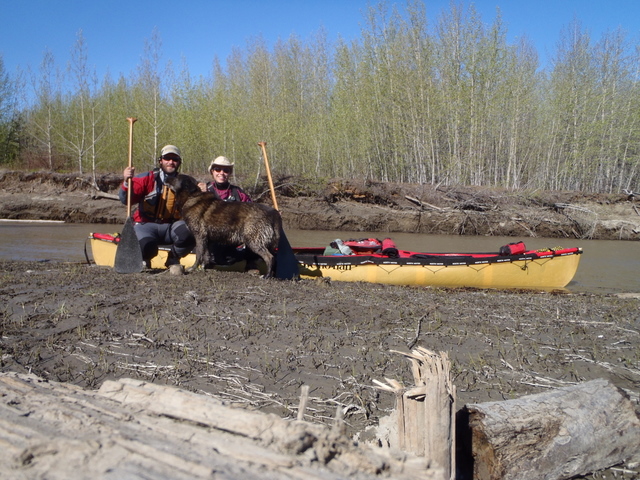Forest Fire on the Tazin River
Have you ever seen a forest fire up close? Well we hadn’t until this past week. On Tuesday as we left Hill Island Lake, we could see smoke toward the south but we figured that it was a long ways away. On Wednesday, the plumes of smoke grew closer and closer as we paddled south on the Tazin River.
By lunch time we were pretty sure that the fire was near our route. The view upriver was one thick, low-lying cloud of smoke. We called the ENR (Environment and Natural Resources) in Fort Smith to see if they knew of any fires in our area. We found out that there were three fires not very far away from us. The one of concern was burning near the Northwest Territories, Saskatchewan border.
We were about five miles from the border. We proceeded with caution, but only made it another couple of miles after lunch. The eastern side of the river was on fire. Not only did we see thick clouds of smoke billowing up from the spruces, but we saw patches of flames here and there. Fortunately for us, the wind was blowing the smoke away from us.
A gravel bar provided us with a perfect spot to stop and watch what was going on upriver. We waited there for several hours. We set up our tent and ate dinner as we observed the smoke and flames creep ever closer to the eastern shore of the river. After several hours the fire had reached the river’s edge and a small stand of Jack Pine ignited in a plume of flames and smoke. In less than a minute the ¼ mile section of the river near us had erupted in flames. The raw energy of the fire became very real as we felt the heat and listened to the inferno. All we could to is stand in awe.
Within 10 minutes the flames were gone, leaving a giant stand of black smoking tree trunks. We decided the fire was getting too close for comfort so we packed up the canoe and retreated north, hoping the fire would die down overnight and let us pass in the morning.
As we slept the fire jumped the river and continued burning to the west. Small fires burned on both sides of the river and the smoke-filled river channel was not very inviting. We called the ENR again and learned that they were sending a helicopter out later in the day to get a look at the fire. So we decided to take it easy and wait. Around 3 PM we heard the drone of the chopper and watched as it came in for a landing on the gravel beach 100 feet from us. Two ENR officers in yellow jumpsuits hopped out and explained that the fire had burned out along most of the river and that the “head” of the fire had moved several miles west of the river. They advised that we paddle through the recently burned area right way because the winds were predicted to change overnight.
We casually chatted for a few minutes and then they hopped back in the helicopter and flew way. We were left a little dumbfounded, but excited about continuing our journey. As we paddle through the smoke filled channel, we marveled at the blackened trees and patches of green left by the fire. Small fires still burned on both sides of the river, but we never felt in danger. We paddled well into the night talking about the natural phenomenon we had just witnessed, finally stopping to pitch out tent many miles from the fire at 1 AM.












